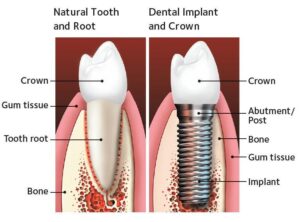Did you know that missing teeth can cause your other teeth to drift out of position, change your bite, lead to tooth decay or gum disease, and even change the way your face looks? Whether you lost a tooth due to injury, gum disease, or decay, there are multiple options to replace missing teeth and restore function.
Dental Implants
Dental implants are often considered the gold standard for tooth replacement. They can replace a single tooth, multiple teeth, or even be used to support a full set of dentures to make them more stable. Although not perfect, implants come closest to looking and feeling like a natural tooth.
Not everyone is a good candidate for implants. Since implants are placed surgically into the jawbone, you must either have adequate bone to support the implant or be able to have the area grafted artificially with bone. Poor hygiene habits, periodontal (gum) disease, tobacco use, or certain chronic illnesses such as diabetes or leukemia can compromise implant healing and long-term success.

The implant process can range anywhere from 2 visits to 2 years depending on how complex your specific situation is. The implant itself is a screw made of a strong but lightweight metal called titanium which is biocompatible with the human body. An oral surgeon places the implant into the jaw, and it takes a few months for it to fuse and integrate into the bone. Once the implant is integrated and healed, an abutment/post and a dental restoration (crown, bridge or denture) will be placed securely on top.
Tooth-Supported Fixed Bridges
A tooth-supported bridge is a great alternative to dental implants. It involves filing down natural teeth on either side of the missing tooth. These teeth will receive crowns that are attached to a “fake” crown called a pontic to fill in the missing space. A bridge is cemented into place and not removable. The process usually takes about 2-3 visits over the course of a few weeks.
While a bridge is less invasive and more economical than getting an implant, it is not considered as conservative since it requires shaving down natural teeth which may otherwise not need to be touched. A bridge is also more tedious to clean around and requires the use of a waterpik and/or floss threaders to maintain good hygiene.

Removable Prostheses
Removable prostheses such as partial or full dentures were once the traditional choice for teeth replacement. Partial dentures often have metal or plastic clasps that hook around teeth to help hold them in place. Full dentures rely on a suction effect or even denture adhesive to hold them in place.
Partial/full dentures are the most economical tooth replacement option and are easy to repair or replace. They do not look and feel as natural as implants or fixed bridges and are often uncomfortable. They need to be removed daily and sometimes after each meal. These types of removable prosthesis can move around when eating or speaking, even with the use of adhesives.
Although removable partial/full dentures are not desirable, they are a good option either permanently or temporarily for those who may not qualify for dental implants or fixed bridges due to anatomical or financial constraints.
Long Term Success
Tooth replacement with implants, bridges, or removable prostheses can reestablish proper functioning, bite, and facial esthetics. However, even the best dental treatment can and will eventually fail. Decay can develop even around well sealed crowns and bridges, bone loss can occur around implants, and teeth can fracture due to grinding habits. Furthermore, dental restorations are artificial materials and just like cars, roads, or sneakers, they experience wear and tear which can cause porcelain to chip, implant screws to loosen, and clasps can snap off. No man-made material lasts forever but proper dental hygiene, good dental habits, and a healthy diet can prolong the life of restorations and your overall dental health.


